Note
Click here to download the full example code
InfraRed imaging Vedeo Bolometer#
Synthetic diagnostics calculation of InfraRed imaging Vedeo Bolometer (IRVB).
Here is a demo program assuming for IRVB at ITER. The parameters for the IRVB are describled in IRVB_conf.yaml file as follows:
#################################################
########## IRVB configuration #############
#################################################
# setting parameters for:
# 1. IRVB camera
# 2. raysect
# 3. IMAS
# === 1. IRVB Camera Setting ==================================================
camera:
C9: # camera variant
Diag: IRVB_E12R # diagnostics
Name: IRVB_view_f=21cm # user-specific name
P: [-5.960767, -6.205868, 0.82] # centre position of slit (x, y, z)[m]
F: 21.0e-2 # focal length [m]
D12: [7.0e-2, 9.0e-2] # foil size (dx, dy) [m]
N12: [28, 36] # pixel resolution
nIn: [0.8365163037378079, 0.2241438680420134, -0.4999999999999998] # direction verctor
pixel_samples: 1000 # specific number of pixel samples
# === 2. Raysect ray-trace common setting =====================================
raysect:
camera: C9 # camera variant
reflection: False
los_step: 1.0e-3 # line integration step [m]
pixel_samples: 1000 # default number of pixel samples
savedir: ../output # destination
# === 3. IMAS setting =========================================================
ids:
# ids fundamental parameters
shot: 134000
run: 15
user: public
database: iter
# For core, edge_sources ids
source: "radiation"
particle: "electrons"
# time (-1 means selecting the first one)
time: -1
This yaml file must be put into the same folder as the python script.
Python script#
module loading
import numpy as np
import matplotlib.pyplot as plt
from raysect.core import translate, Point3D, Vector3D, rotate_basis
from raysect.primitive import Cylinder
from raysect.optical import World
from raysect.optical.observer import PinholeCamera, PowerPipeline2D, MonoAdaptiveSampler2D
from raysect.optical.material import VolumeTransform, AbsorbingSurface
from cherab.tools.emitters import RadiationFunction
from cherab.iter.tools.visualization import plot_2D_data
from cherab.imas import EquilibriumIDS, CoreSourcesIDS, EdgeSourcesIDS
from cherab.iter.machine import import_iter_mesh
import yaml
import argparse
Define Initial condition#
Load setting file (yaml)
with open("IRVB_conf.yaml", "r") as file:
conf = yaml.safe_load(file)
# obtain arguments
parser = argparse.ArgumentParser()
parser.add_argument(
"-c", "--camera", required=False, help="camera case must be choosed cases wiritten in conf.yaml"
)
parser.add_argument("--run", required=False, type=int, help="run number is IMAS ids run number")
args = parser.parse_args()
# IDS setting
SHOT = conf["ids"]["shot"]
if args.run:
RUN = args.run
else:
RUN = conf["ids"]["run"]
USER = conf["ids"]["user"]
DATABASE = conf["ids"]["database"]
SOURCE = conf["ids"]["source"]
PARTICLE = conf["ids"]["particle"]
TIME = conf["ids"]["time"]
# raysect setting
if args.camera:
case = args.camera # select camera case by arguments
else:
case = conf["raysect"]["camera"]
print(f"Set camera: {conf['camera'][case]['Diag']} -case: {case}")
Reflection = conf["raysect"]["reflection"]
los_step = conf["raysect"]["los_step"]
Define radiation function#
The radiation from plasma consists of loss of electron energy in edge and core region. Here we define the \((X, Y, Z)\) coordinates function.
print(f"importing shot:{SHOT}, run:{RUN}, source:'{SOURCE}', particle:'{PARTICLE}'")
equilibrium_ids = EquilibriumIDS(shot=SHOT, run=RUN, user=USER, database=DATABASE)
equi = equilibrium_ids.time(TIME)
core_sources = CoreSourcesIDS(shot=SHOT, run=RUN, user=USER, database=DATABASE)
edge_sources = EdgeSourcesIDS(shot=SHOT, run=RUN, user=USER, database=DATABASE)
# extract energy data
core_sources.energy(source=SOURCE, particle=PARTICLE, equilibrium=equi)
edge_sources.mesh().energy(source=SOURCE, particle=PARTICLE)
# create radiation distribution function
energy_2D = core_sources.map2d() + edge_sources.map2d()
energy_3D = core_sources.map3d() + edge_sources.map3d()
Create Primitives#
# -------- set const. --------- #
# set plasma profile r,z range
RMIN, RMIN = edge_sources.r_range
ZMIN, ZMAX = edge_sources.z_range
CYLINDER_RADIUS = RMIN
CYLINDER_HEIGHT = ZMAX - ZMIN
# last wall r,z range (terminal absorbar)
WALL_RMIN = RMIN - 1.0
WALL_RMAX = RMIN + 1.0
WALL_ZMAX = ZMAX + 1.5
WALL_ZMIN = ZMIN - 1.0
# ----------------------------- #
# World
world = World()
# Cylinder as teminate wall
central_column = Cylinder(
WALL_RMIN,
WALL_ZMAX - WALL_ZMIN,
material=AbsorbingSurface(),
parent=world,
transform=translate(0, 0, WALL_ZMIN),
)
# ITER PFC meshes
mesh = import_iter_mesh(world, reflection=Reflection)
# Plasma emitter
# We shift the cylinder containing the emission function relative to the world,
# so need to apply the opposite shift to the material to ensure the radiation
# function is evaluated in the correct coordinate system.
shift = translate(0, 0, ZMIN)
radiation_emitter = VolumeTransform(RadiationFunction(energy_3D, step=los_step), shift.inverse())
# Plasma
geom = Cylinder(
CYLINDER_RADIUS, CYLINDER_HEIGHT, transform=shift, parent=world, material=radiation_emitter
)
Add IRVB camera as an Observer#
Camera configuration (position, orientation, etc.) is loaded from yaml file.
Pinhole is used as IRVB camera.
camera_pos = conf["camera"][f"{case}"]["P"] # camera position
camera_ori = conf["camera"][f"{case}"]["nIn"] # camera orientation
pixels = conf["camera"][f"{case}"]["N12"] # pixel number
focal_length = conf["camera"][f"{case}"]["F"] # focal length
pixel_size = conf["camera"][f"{case}"]["D12"] # pixel size
# Field of view
fov = 2.0 * np.arctan(np.hypot(*pixel_size) / (2.0 * focal_length)) * 180 / np.pi # [deg]
camera_pos = Point3D(*camera_pos)
camera_ori = Vector3D(*camera_ori)
camera_tran = translate(camera_pos.x, camera_pos.y, camera_pos.z)
camera_rot = rotate_basis(camera_ori, Vector3D(0, 0, 1))
# the number of pixel samples
try:
min_samples = conf["camera"][f"{case}"]["pixel_samples"]
except NameError:
min_samples = conf["raysect"]["pixel_samples"]
pipeline = PowerPipeline2D(name="radiation")
sampler = MonoAdaptiveSampler2D(
pipeline, fraction=0.2, ratio=25.0, min_samples=min_samples, cutoff=0.1
)
# generate camera object as a pinhole camera
camera = PinholeCamera(
(pixels[0], pixels[1]),
fov=fov,
pipelines=[pipeline],
parent=world,
transform=camera_tran * camera_rot,
frame_sampler=sampler,
)
Excute ray tracing and Plot a simulated image#
plt.ion()
camera.observe()
plt.ioff()
fig = plt.figure()
fig, grid = plot_2D_data(
fig=fig,
data=[np.rot90((pipeline.frame.mean), k=1)],
ax_row=1,
plot_mode="log",
titles=[f"run: {RUN}"],
clabel="[W]",
title_params={"fontsize": 12, "y": 0.9},
)
plt.savefig("radiation_JINTRAC.png", bbox_inches="tight")
plt.show()

Total running time of the script: ( 0 minutes 0.000 seconds)